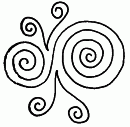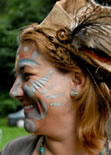Following the Red Thread
Making as a form of Active Imagination and how Making is tied to larger theme of the Five Stages of the Mythic (Family) Journey as you are developing it with Gail Straub and her Spiritual Growth Retreats:
The Call
Do you respond or not? Now or later?
What Images present? a Dark Forest, a Great Tree, a Babbling stream, a Lowly Messenger
Are objects involved?
Are these objects aids, boones, bribes or distractions?
Is this anxiety causing? birth/separation?
What are the colors of all this?
The Journey
Is there a Guide?: a crone, dwarf, wizard, smith, hermit, shepherd…
Are there objects/amulets? feathers, earth, wands, elementals: metal, water, air, quills? Should you/Do you have to gift him/her? Gift someone!
The Descent into Darkness
Oh, that death! those Wounds! What??... Healing? ....Me?
The Epiphany/Initiation:
What objects, what colors, forms, textures accompany this experience?
The Ascent/Return
Create a Community Loom… where all add and intersect their stories.… to find the the inherent commonalities.
Questions:
Is one stage "easier", more comfortable, more prominent?
Is another stage seemingly a mystery?
Making Imaginal Artifacts
--small cards or objects-- for each phase also addresses what I call The Four Needs-- really quite simple and obvious:
1. We have the Need for Awe and Wonder. We have the need for Play, deep play, not just recreation or hobbies or sports.
Questions:
When and How do you Play? When have you been Awed? felt Wonder?
Suggestions:
Make cards/devices to celebrate and remind you the times and ways you know awe.
2. We have the Need for The Carnal. We are animals and respond to the elements; we have a reptillian brain. Put in a bit less feral way, we have the Need for the Organic. We need to experience the relentless cycles of nature and of our human nature. We are a part of that. Making can help create and re-create our connections.
Questions:
When and where do you feel most earthen?
Another way to put it: What do you stoop over to pick up and bring home from the beach, the woods, the park? What animals attract you, or attract around you?
3. We have the Need for Dexterity. We need to see ourselves as capable, learning creatures. We can learn to do new things, learn new skills, crafts, arts, technologies. On a more profound, but no more important level, it is addressing our Need for the Capacity to Transform. We need to see outrselves as Changing, as Changlings. We know it happens, but we need reminders and reminders that we participate in.
Questions:
What are your most common hand-eye skills? What are you learning to do?
What seems a persisting challenge?
Suggestions:
First, Honor-the Ways-You Know Best Make somethinbg using a technique and in a scale you are confident about. Next, try/learn a new way
4. We Need Stories. That's what Red Threads is really about:
following that red thread and falling back into our stories and the stories of
others...Making things is a way of elaborating parts of the story not as easily accessible to words Kurt Vonnegut describes a story very simply: "Man in Hole, Man gets out of Hole" Read Portia Nelson's Autobiography in 5 Chapters.
Tunnel Dream Card by Lee Langstaff
Questions:
What storylines, what Old Themes (archetypes) keep rising to the surface?
Is there a Magical Other you are pursuing?
Suggestions:
Honor and Express them in a card or device...(This might be an entire Suit of you personal Deck of Cards or a whole Tool Drawer in your Imaginal Workshop)
Then Create a Response.
Make another card/device which modifies the old way.
Ask: "What if that theme resolved, that wound healed, that track went untraveled (You "took another street" as Portia Nelson might put it) ."
Thomas Moore might call these objects "magical decoys", to help attract and form your stories. They are tools for powerful imaginal and re-imaginal tasks.
Patricia Goodwin's Decay
Another Approach
Limit your card-making to just a few colors of tissue paper. This allows for a depth of expression using just color, texture, form and the endless possibuility of overlay. Tissue paper is semi-transparent when moistened with glue.
The colors of the Four Directions: Red, Green, Black and White
Another Approach
Start with a band aid and a card. Where do you go? Do this five or ten times.
What happens to your Wound?
Another Approach
We are not never alone. We are part of a web, a matrix, a pattern.
Be quiet and start to recognize the Others attached to you in this loom of life:
who are the people? the animals? the experiences? the trees and rocks?
Make cards to recognize them.
Another Approach
Choose a single form of joinery. Hold things in place with just paperclips, or staples, or a gluestick, or gravity, or hot wax, or tape, or only sew things to the card.
Another Approach
Read about The Magical Other. Make some cards for your Magical Other.
All these suggestions and approaches are PORTALS, momentary or perhaps lingering Ways In to Elsewhere.
References/Review
Handouts #1 #2 Portia Nelson Poem Laraine Herring Poem
Imaginal Artifacts are sculptural objects which resemble tools, furniture, art, but perform ambiguous and changing functions. more
Woodlanders Gatherings are where many of have met for 10 years
Sometimes we meet on-line in creativity salons more
My books, The Adirondack Chair and The Hammock use very common objects as prisms into personal and collective stories.
My in-process creative autobiography, Hair on the Shower Wall goes into more detail than you might be able to stand!
Getting Ready for an Imaginal Artifacts Workshop
Review the Questions I posed about our Needs... which ones are "hotter" for you.
Look over this general Getting Ready
Haiku is a fundamental inspiration in my object-making work:
A brief expression of something Seasonal, Personal and Eternal
What To Bring to an Imaginal Artifacts Workshop
Bringing a few things is a powerful investment in the Pot-Luck nature of this experience... where each person contributes to the feeding of the group: a few band-aids, some string, thread or wire, a small amount of white or carpenters glue, a cordless drill (quite optional), a few small pieces of colored tissue paper, a small collection of natural materials from your neighborhood, a few objects/papers from the drawers in your desk, nightstand or dresser, a few natural materials you've collected and moved with you over the years--the Why Am I Saving This?--stuff. From your journals, bring several of your favored or repeating dynamic tensions. Those are qualities that might seem like opposites, but usually come in pairs. I call them The Affinities. Some examples
How an Imaginal Artifacts Workshop worked
Red Thread Retreat, September 25-26, 2009
On Friday evening (2 hours), we began just arranging
some stones to see how quickly a story line can develop.
Then we made many small collages -2 1/2" x 3 1/2"- Imaginal Trading Cards. Here are my most currrent ones.
On Satyrday morning (4 hours), we explored the meadows, woodlands and Hudson River bank for materials to make 3-D Imaginal Devices.
Questions to moodle with after a Workshop
What's recurring?
What themes, shapes, colors, compositions?
Are certain "suits" of cards beginning to form??
Patricia Goodwin's 5 Chinese Elements

